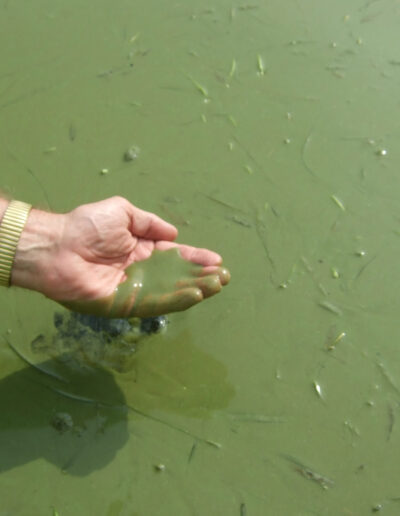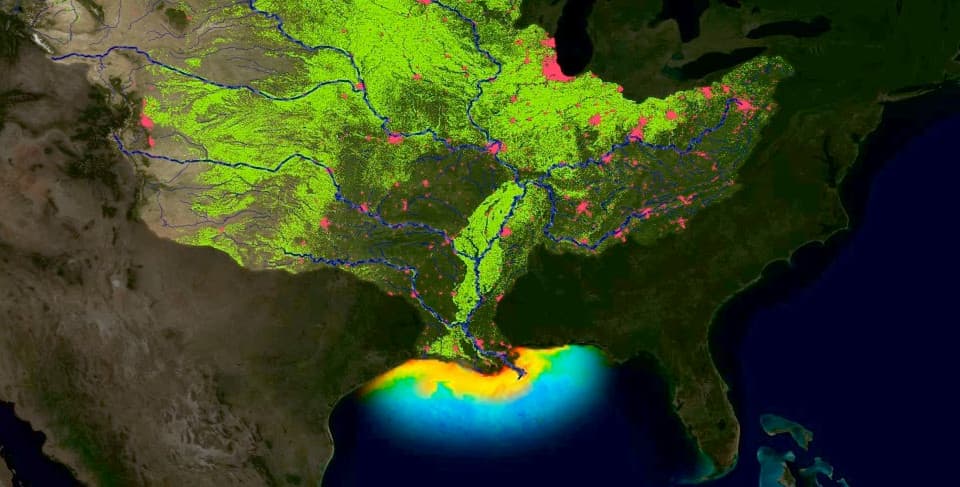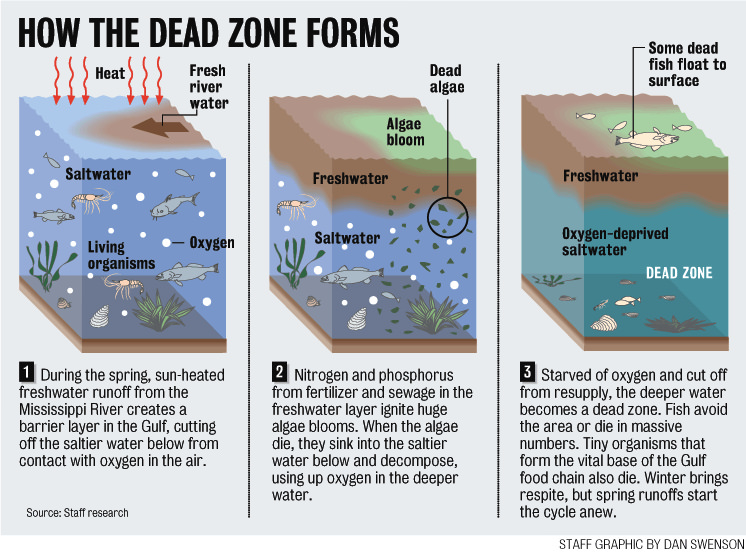5 need-to-knows about Mississippi River Nutrient Pollution in 2019 and how you can help
Yes.
So, what’s the issue? What do you mean nutrient pollution?
Nutrient pollution is what we are seeing in our waterways today. It’s jeopardizing clean drinking water for 20 million people in the Mississippi River Basin and it fuels the notorious Gulf of Mexico hypoxic (low to no oxygen) ‘Dead Zone’.


But let’s back up a step.
Your 8th-grade science teacher wasn’t lying to you -yes, life requires nutrients like nitrogen and phosphorus. You, me, terrestrial and aquatic plants, animals, etc.
However, an excess of nutrients is currently washing into the Mississippi River system and polluting the water. A major source of excess nutrients, like nitrogen (N) and phosphorus (P), comes from human practices on land, in particular, intensive fertilizer applied in industrial agricultural settings.
Plants can only fixate, or use, so much of a given nutrient at a time. The excess nutrients are then often washed by precipitation downhill and downstream, flowing into bigger waterways, and in the case of ~40 percent of the continental U.S., drains into the Mississippi River and the Gulf of Mexico.

How has record flooding in 2019 across the Mississippi River Basin affected nutrient loading into the Gulf of Mexico? The experts at NOAA are saying the high water has flushed above average amounts of nutrients out to the Gulf and they are predicting this year’s Gulf hypoxic zone to be one of the largest on record at approximately 7,829 square miles (size equivalent to the total landmass of Massachusets).
NOAA goes detail with:
“this past May, discharge in the Mississippi and Atchafalaya rivers was about 67% above the long-term average between 1980 and 2018. USGS estimates that this larger-than average river discharge carried 156,000 metric tons of nitrate and 25,300 metric tons of phosphorus into the Gulf of Mexico in May alone. These nitrate loads were about 18% above the long-term average, and phosphorus loads were about 49% above the long-term average. ”
So, to connect the dots, this infographic explores visually how nutrient pollution fuels and forms the Gulf of Mexico Dead Zone:

In summary, here are the 5 need-to-knows about Mississippi River Nutrient Pollution in 2019 and how you can help:
- Nutrients, like nitrogen and phosphorus, are essential for life, and what we are seeing today in the Mississippi River is an EXCESS of nutrients.
- Nutrient Pollution in the Mississippi River is primarily from human activities including agricultural practices and urbanization.
- Nutrient Pollution is the primary driver spurring and fueling the Gulf of Mexico hypoxic (low to no oxygen) Dead Zone which has rippling negative environmental, social, and economic effects.
- Historic flooding of 2019 has exacerbated nutrient loading into the Gulf of Mexico and experts are forecasting the hypoxic zone to be on the largest on record at around 7,829 square miles.
- PROVEN SOLUTIONS EXIST and require basin-wide effort, coordination, and funding. Take action today by signing this petition from the Mississippi River Network calling on congress for the necessary funding for proven solutions to nutrient pollution.
Thank you for reading! The official measurements for the Gulf of Mexico 2019 Hypoxic Zone will be occurring at the end of July with the report in August. Please take action by signing the petition and email info@1mississippi.org with further questions.
For the River,
Michael Anderson, Mississippi River Network
Resources:
Join our
COMMUNITY
And Get a Free E-book!
When you sign up as a River Citizen you’ll receive our newsletters and updates, which offer events, activities, and actions you can take to help protect the Mississippi River.
You’ll also get our free e-book, Scenes From Our Mighty Mississippi, an inspiring collection of images featuring the River.
Step 1
Become a River Citizen
Yes! The River can count on me!
I am committed to protecting the Mississippi River. Please keep me informed about actions I can take to protect the Mississippi River as a River Citizen, and send me my free e-book!, Scenes From Our Mighty Mississippi!
Step 2
LEARN ABOUT THE RIVER
We protect what we know and love. As a River Citizen, you’ll receive our email newsletter and updates, which offer countless ways to engage with and learn more about the River. You can also follow us on Instagram, Facebook, X (Twitter) , and YouTube, where we share about urgent issues facing the River, such as nutrient pollution, the importance of floodplains and wetlands, and bedrock legislation such as Farm Bill Conservation Programs.
Step 3
Take Action
There are many ways you can jump in and take action for a healthy Mississippi River. Our 10 actions list includes simple steps you can take at any time and wherever you are. Check out our action center for current action alerts, bigger projects we are working on, and ways to get involved.
